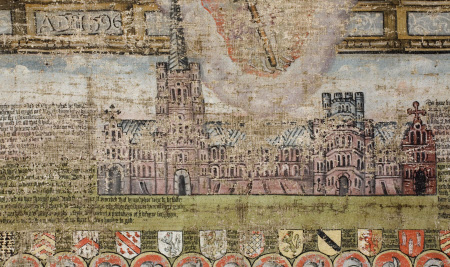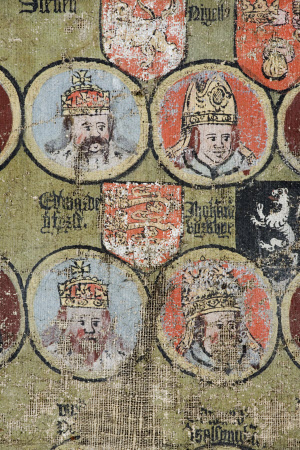Tabula Eliensis
British (English) School
Category
Art / Oil paintings
Date
1596
Materials
Oil on linen
Measurements
2300 x 2600 mm
Order this imageCollection
Coughton Court, Warwickshire
NT 135719
Summary
A framed painted cloth, now known as the Tabula Eliensis, oil painting on linen, English School, dated 1596. The painted cloth presents a history of Ely through written English, painting and heraldry. Ely Cathedral is depicted at the top in the centre of the cloth with a partial image of the Resurrection above. The text to either side of the Cathedral uses a New Testament story to discuss the importance of charitable foundations and the former role of monasteries in society. This is surrounded by an early history of the monastery at Ely from its foundation in 607 up to William the Conqueror (r. 1066-1087), told through a series of portrait roundels of key individuals, followed by a sequence of the 40 Knights whom were said to have been stationed at Ely by William. The middle section contains a chronological series of portrait roundels of monarchs to Elizabeth I (r. 1558-1603) with their abbots, priors, deans and bishops of Ely. Beneath these, at the bottom of the cloth, are the arms of 29 Catholic gentleman interned at Ely, Banbury and Broughton between 1588 and 1594.
Full description
In 1588, Philip II of Spain (r. 1556-1598) assembled a substantial fleet and set sail for England, reaching the English Channel. A successful Spanish invasion – and subsequent return to Catholicism – felt quite plausible. Famous for being defeated, the Spanish Armada was the first of several invasion attempts. Between 1588 and 1595, England was on high alert, with repeated periods of increased tension with Spain (i). Under sustained threat, Elizabeth I and her advisors questioned the loyalty of some influential Catholics in the event of Spanish invasion. Suspected of harbouring Jesuits, these individuals were thought by the queen’s chief counsellor William Cecil, Lord Burghley (1520/21-1598), to be more likely to pass intelligence – and potentially spies – amongst their networks (ii). During times of heightened risk, the most influential of these individuals were interned, with restrictions placed on their movement and communication (iii). The painted cloth at Coughton records the coats of arms of 29 elite lay Catholics interned at Ely (1588, 1590, 1592-3 and 1594-5), Broughton (1590, 1592-3 and 1594-5) and Banbury (1594-5). The arms of Thomas Throckmorton of Coughton Court (born by 1536-1615) are found in the third, fifth and seventh columns, recording his confinement at Broughton (1590 and 1592-3) and Banbury (1594). It is not known who made or commissioned the painted cloth or when and how it came to be in the care of the Throckmorton family at Coughton Court. The earliest documentary record of the painted cloth at Coughton Court is an undated description. This is endorsed in a hand thought to be that of Sir Robert Throckmorton, 3rd Baronet (1662-1720/21) who recorded ‘ye picture in Coughton Galerie’ (iv). (i) Meg Twycross, unpublished research report (2024), p. 27. (ii) TNA SP12/248/9, f.25r-26r. (iii) Twycross (2024), pp. 38-40. (iv) Warwickshire Record Office, CR1998/J/Box 84.
Provenance
Recorded at Coughton Court before 1720/21 and thence by descent through the Throckmorton family. Purchased by the National Trust in 1992 through private treaty sale with aid from the National Heritage Memorial Fund.
Makers and roles
British (English) School, publisher



